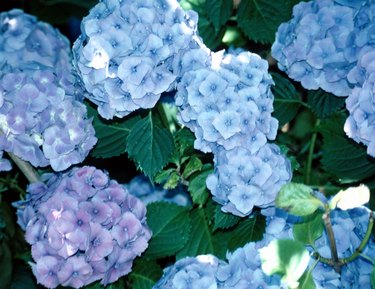
The colorful huge blooms of the hydrangea make them a perennial favorite in gardens as well as for patios and sun rooms. While some people choose to transplant hydrangeas from pots into the soil, the plants are hardy enough to survive in potted containers. Hydrangea flowers are long lasting and the plants grow into stunning bushes that bring beauty wherever they are placed. The key to healthy potted hydrangeas lies in their care.
Soil Tips
Video of the Day
Hydrangeas will grow in cool to moderate climates with temperatures ranging between 50 and 60 degrees. They generally bloom from early summer through autumn.
Video of the Day
According to Home Herb Garden hydrangeas range from off white to colorful shades of blue, green, pink, purple and red. Color can be altered by adjusting the acidity of the plant's soil. Test the soil with a soil pH testing kit according to the kit's directions. Blue flowers require a pH of 6.5 or lower while the pink shades need a pH of 7.0 or higher. Add aluminum sulphate to soil before the plant produces buds to get blue flowers; add superphosphate to attain pink flowers.
Water plants well in hot weather and keep them out of direct sun. Never; however, allow them to stand in water as that may cause root rot.
Flower Shop Network says hydrangeas like moist soil because they prefer a semi-sunny location.
Bella Online recommends fertilizing a few times during the growing seasoning, following the instructions for the type of fertilizer chosen.
When plants outgrow their pots transplant them into larger containers. Use rich potting soil mixed with equal parts of peat moss or sand for good drainage.
Watch out for insects like aphids, slugs and snails on outdoor hydrangeas both on the plant and in the soil. Treat with a pest controller specifically designed for hydrangeas.
Pruning Tips
Hydrangeas can be pruned to maintain help the plant's shape and size under control. Deadhead it regularly to remove its spent blooms and leaves but do not prune immediately after transplant. Give the plant time to adapt. Deadheading means removing wilted blooms by cutting the flowering portion off right below the bloom. Pruning is not advisable at the end of summer through fall since the plant may not harden sufficiently for surviving cold temperatures.
Every three years root prune the hydrangea in the early spring before the plant starts budding. Remove the plant from its pot and carefully remove clumps of old or rotting roots. Then replant it into its existing container or move to a larger one as indicated in the steps noted above.
Eliminate old wood yearly before summer blooming begins. Cut away dead, rotted or weakened stems down to the last buds. While this may mean the plant won't flower completely during that summer, it will jump start new growth and result in a healthier overall plant.
Winterizing Tips
Winter protect potted hydrangeas by one of several acceptable methods according to HydrangeasHydrangeas.com. The first recommendation is to bring the plants inside to a garage or cellar that can be heated to protect the plant from freezing. Another is to wrap hydrangeas carefully with 1/2-inch thick foam, taping it completely shut to keep the frost away. You can also cover the potted part of the plant with insulation materials to protect its inner core. In most cases this will ensure spring regrowth.